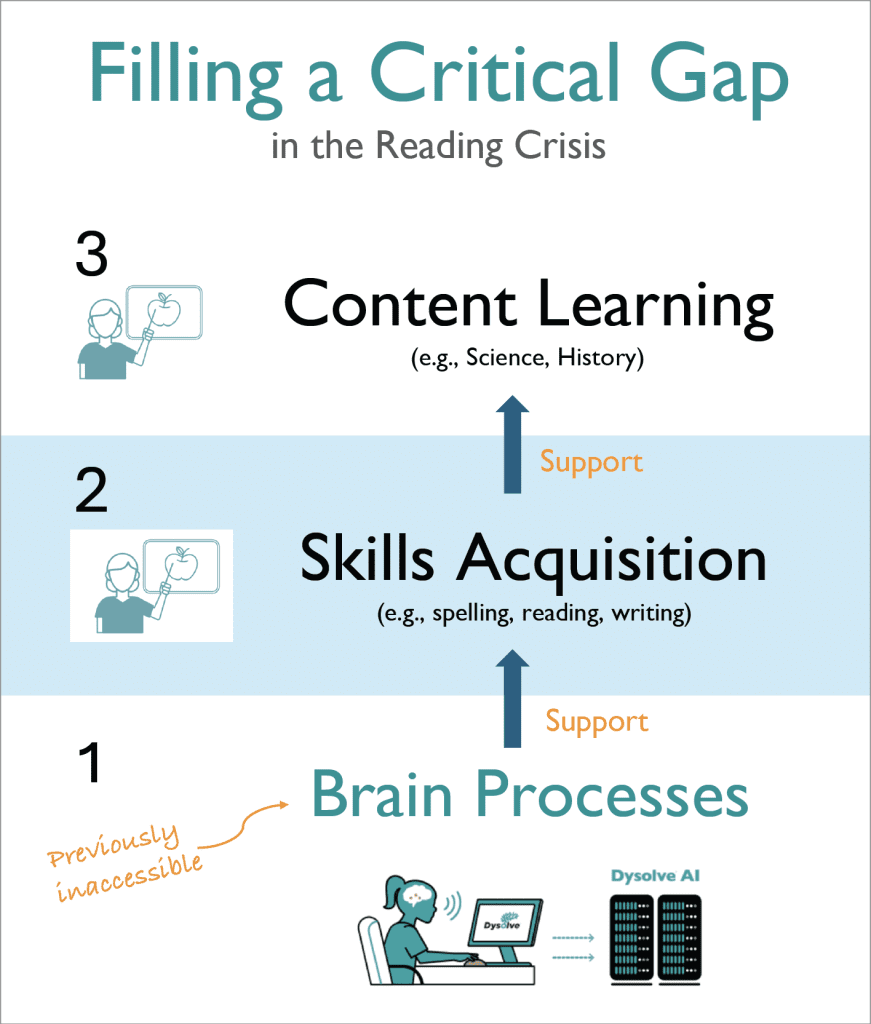Families often ask us whether their struggling readers should get tutoring concurrently with our Dysolve AI intervention. Reading difficulties that are neurologically based are called dyslexia. Dyslexia is due to language processing issues in the brain and is very common, affecting 1 in 5 people.
The type of tutoring for dyslexia is usually Orton-Gillingham. For families, it is an important question because Orton-Gillingham-trained teachers may command over $100-$200 an hour. The teachers themselves have invested much into getting trained and certified to assist students with dyslexia.
Orton-Gillingham merits our attention because:
- It is the primary method used in and out of school
- It is promoted by dyslexia authorities and advocacy groups
- It is mandated in some states for dyslexia intervention
Orton-Gillingham has gained prominence primarily through extensive advocacy, legislative support, and widespread recognition among schools and families. However, it’s important to critically evaluate its long-term effectiveness and cost implications. Families deserve evidence-based alternatives that leverage modern technology and neuroscience, potentially offering equally or more effective solutions without the high hourly costs associated with traditional Orton-Gillingham tutoring.
What is Orton-Gillingham?
Orton-Gillingham is an instructional approach characterized by:
- multisensory teaching strategies
- systematic, sequential lessons
- phonics instruction
Multisensory teaching is part of early literacy instruction

Generally, it is a good idea to use more than one sensory modality to engage young children and help them retain information. Indeed early childhood education uses multisensory instruction often. Literacy instruction is no exception. Teachers may have children look at sight words, sound out the letters and count the number of sounds with their fingers.
With Orton-Gillingham multisensory approach, students try to remember the sound of a letter, say, by tracing and feeling letter shapes. But how is Orton-Gillingham multisensory teaching different from general multisensory instruction? What does the research say?
In 2014, Durham and Yale professors Julian Eliott and Elena Grigorenko published their comprehensive review of dyslexia research (The Dyslexia Debate, Cambridge Press). In summarizing studies on this component of Orton-Gillingham, the authors conclude that “research has offered no compelling evidence that a multisensory approach can benefit children with reading difficulties” (The Dyslexia Debate, p. 150).
How, then, did the multisensory approach get associated with Orton-Gillingham? For the answer, we turn to Orton-Gillingham’s origin. The multisensory instruction for dyslexia was developed by Samuel Orton and Anna Gillingham in the 1930s. At that time, neuropsychiatrist Orton and psychologist Gillingham mistakenly hypothesized that dyslexia was a vision problem. That turned out to be incorrect.
Dyslexia was later found to be a language problem, but Orton and Gillingham’s multisensory approach continued to be promoted by the Orton Society, which later changed its name to the International Dyslexia Association.
Systematic, sequential lessons are part of general literacy instruction

Reading and writing are complex language tasks. To teach any skill related to language, it makes sense to approach it systematically. Natural language is studied scientifically in Linguistics. In an introductory Linguistics course, one might study natural language structurally, covering key components and their building blocks methodically. This is Structural Linguistics.
By extension, structural components of natural language would be covered systematically in literacy instruction. The term “structured literacy” is used often in reading remediation and implies this systematic, structural approach. Structured literacy deals with language as an object made up of units from small (sounds) to large (sentences). Orton-Gillingham incorporates structured literacy, as do other intervention methods.
However, knowing the structural components of language and reading is not enough to resolve dyslexia. We need to know how the brain processes these components, especially nontypically developing brains.
Without this knowledge, we cannot determine the appropriate sequence of instruction for a student. The intervention has to be highly individualized, for the same sequence does not apply to everyone.
Phonics is part of general literacy instruction
For an alphabetic writing system like English, phonics is essential. Phonics involves letter-sound relationships. For typically developing readers, teaching which sounds associate with which letters, and what diphthongs go with what letter combinations makes perfect sense.
However, phonics instruction is not so straightforward for children with dyslexia. Over 40 years of research has established a strong correlation between dyslexia and phonological processing. That is, individuals with dyslexia tend to lack phonological awareness, or sensitivity to the sounds and sound patterns of natural language.
If so, phonics instruction, even if administered systematically and sequentially, may not be effective. This may explain why schools and tutors go through full sets of lessons on phonics, but their struggling readers still keep failing year after year.
Through our Dysolve AI work, we hear from students from across the country. The students tell us that their teachers’ instruction “does not make sense.” Phonics instruction does not make sense to individuals who cannot process speech sounds. Because of this, letter shapes hold no meaning to them, no matter how many sensory activities they go through.

Missing Component: Language Processing
Dyslexia is a language processing problem. Research shows that the processing of sound units is problematic for many individuals with dyslexia. Other units of language, from syllables to words, phrases and meaning are also implicated.
Language processing inefficiencies are at the root of dyslexia. Humans cannot resolve the dyslexia problem due to the complexity of the linguistic system in the brain, the speed of language processing, and the capacity needed to cross-reference billions of datapoints to evaluate and correct language processing inefficiencies.
Therefore, effective dyslexia intervention requires computing technology. At Dysolve, we use AI technology to correct language processing inefficiencies. Thus, Dysolve is designed to correct dyslexia.
Without this capability, interventions like Orton-Gillingham can only compensate for the disability.
Is Orton-Gillingham Evidence-Based?
First, let us understand what “evidence-based” really means. According to the Department of Education’s Institute of Education Sciences, the term “evidence-based” can be used when there is a rationale, based on research findings, that the practice is likely to improve student outcomes, with ongoing efforts to examine such effects.
That is, methods called “evidence-based” do not necessarily have evidence of positive effects. Indeed, the “evidence-based” methods listed in What Works Clearinghouse do not show positive effect for reading achievement for struggling learners in grade 3 and up.
The Dyslexia Debate pointed out the lack of efficacy of Orton-Gillingham in 2014. Since then, other researchers have continued to echo this lack of evidence periodically, including in 2021 and 2022 reviews. The reviews find that many studies lack scientific rigor.
Some methods show positive effect in some aspects of literacy, such as alphabetics or phonemic awareness. But that is not enough. What we need is evidence of improvements in reading overall, to prove that affected students are functioning as well as their peers . Other studies show positive effect in their own measures, instead of objective assessments, namely state or standardized testing.
Is Orton-Gillingham Based on the Science of Reading?
The term “science of reading” seems to imply an authoritative method. But actually the science of reading is simply the body of work collected to date on reading research.
This body of work shows that:
- Teaching the structures and components of language systematically has a positive impact on typically developing children. The evidence is unclear for nontypical populations.
- Orton-Gillingham and other intervention methods have not shown any evidence that they work for nontypically developing children. These methods have not been able to get students below the dyslexia threshold (below 25-30th percentile in reading research) to pass state or standardized reading assessments, after 3rd grade.
- They have not succeeded even when implemented with high fidelity by reading experts/university professors, intensively one-on-one, for sufficient duration and with sufficient resources through state or federal grants.
Inconsistent or Improper Implementation of Orton-Gillingham
When reading outcomes are poor, inconsistent or improper implementation is often blamed. Hence the constant call for more teachers to get trained and for them to get trained adequately. However, it is time to re-examine the method itself if no specialist has been able to get this group to read on grade level consistently for almost 100 years. Moreover, even high quality implementations run by university professors have not succeeded.
Why You Don’t Start with an Orton-Gillingham Tutor
Think of 3 tiers. The bottom tier is brain processing. Brain processes support the acquisition of skills in the middle tier. Skills include spelling and reading. These skills support the top tier, the acquisition of subject matter such as science and history. Orton-Gillingham tutors operate in the middle tier. Dysolve AI works on brain processing in the bottom tier by increasing efficiency.
When language is processed efficiently, skills acquisition can proceed effectively. At that point, a method that teaches literacy systematically should be effective.
What are the Alternatives to Orton-Gillingham
At Dysolve AI, we resolve each person’s dyslexia by approaching the problem logically. After improving language processing, students are ready to learn spelling. The Dysolve Sounds and Spelling Manual teaches them how to recognize phonetic sounds, phoneme-grapheme correspondences, and spelling rules.
Students also need to recognize high frequency words. Word recognition has to occur at great speed for fluent reading to occur. Therefore, spelling and written vocabulary acquisition are logical next steps after language processing.
For these skills in the middle tier, reading tutors or online programs may help older students to catch up with their peers. But only Dysolve AI can solve the root problem – brain processing Deficiencies.
Conclusion
There is a logical approach to follow to answer families’ question about using an Orton-Gillingham tutor. This does not involve loading a struggling learner with all methods that the family can afford, or even the most expensive option they can cover. The quality of impact is not necessarily correlated with the cost of intervention.
Ineffective methods, and even well-meaning teachers, can still cause harm. When much expense and energy have been invested in a child, and yet their reading skills do not improve, self-blame, loss of self-esteem and defeatism may set in. When that occurs, the child may resist any further assistance to address their dyslexia, even when the next one happens to be the one that actually works.




